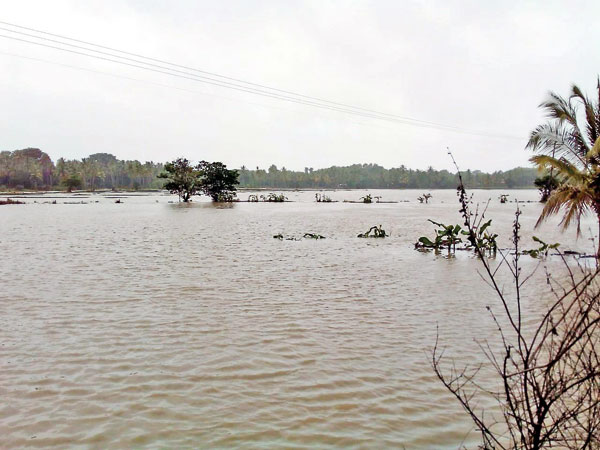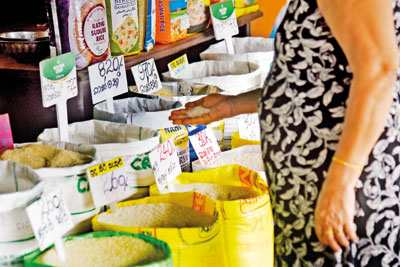News
Flood damage of vast tracts of paddy land likely to deepen rice shortage
View(s):By Kasun Warakapitiya
Sri Lanka’s rice shortage is expected to further worsen after at least 338,000 acres of paddy land were submerged in heavy downpours over the past few days.
Only last week, the Agriculture Ministry had said it would be importing rice as a short-term measure.
But this week’s adverse weather and flooding affected many agricultural districts. Some of the most affected were Ampara, Batticaloa, Jaffna, Vavuniya, Kilinochchi, Mannar, Anuradhapura, and Polonnaruwa—districts where paddy is cultivated on a large scale.
Agrarian Development Commissioner General U.B. Rohana Rajapaksa said the damage was being evaluated. To get a complete assessment, the floodwaters must first recede.

Flooded paddy fields in the rice bowl district of Polonnaruwa. Pic by Nimal Jayarathne.
He said some paddy fields were safe, but it might take more time to get the details.
He estimated that 338,000 acres of paddy lands remained submerged as of Friday while 110,035 acres of paddy have been destroyed.
According to their figures, 137,880 farmers have been affected.
Mr. Rajapaksa said that due to the shortage of rice, recultivation of areas where the crop was damaged was being promoted.
“We plan to recover by urging recultivation to get the expected harvest. There might be a delay of the harvest. We will strive not to allow a reduction of yield,” he said.
Some of the district secretaries said the floodwater had not receded from paddy lands. Newly cultivated crops were also destroyed, while the well-established paddy fields had been damaged.
The Ampara District, an important producer of paddy, was heavily affected, leaving 74,000 acres of paddy land under water. About 5,200 acres of paddy have been completely destroyed.
District Secretary Chinthaka Abeywickrema said officials were trying to further assess the damage and start recultivation of paddy to avert a possible shortage.
He said the harvest would be delayed even with recultivation.
Mr. Abeywickrema said that he was sceptical about obtaining the expected 425,000 metric tonne paddy harvest in the Ampara district, given the flood devastation.
Trincomalee District Secretary Chaminda Hettiarchchi told the Sunday Times that currently more than 25,000 acres of cultivated land were flooded and that damage had not been fully assessed yet.
Batticaloa District Secretary J.J. Muraleetharan said that though the rain had eased, the paddy lands were still inundated. She pointed out that the damage could only be assessed after water levels receded.
The government has said that farmers will be compensated and that seed paddy will be provided. Accordingly, Rs 40,000 would be provided per acre for paddy, potato, corn, soya, big onion, and chili.
Trade sources said the Consumer Affairs Authority had already scaled down raids, fearing a future shortage of rice if they strictly implement price controls.
According to these sources, the Consumer Affairs Authority is stuck in a helpless position as they have to ensure the availability of rice, maintain price controls, and stop millers from manipulating paddy prices in the upcoming harvesting season.
They said that although rice had been imported before, only a few shipments had come ahead of the festive season.
The sources also fear that imports would be inadequate as the flooding had destroyed large areas of paddy lands.
“Ampara paddy fields, which normally provide the first yield of the Maha season, were severely affected by floods. Definitely, harvesting scheduled for the end of January would be delayed,” the sources said.
The sources pointed out that the lack of buffer stock in government storage had given the main millers the leverage to dominate the market, increase demand, and sell rice for higher prices by slowing down production and creating shortages.
The Sunday Times also learned that the farmers also hold back 25% to 50% of their yield for their consumption and to cultivate some of it in the next season.
Meanwhile, there are farmers and other middlemen offering storage to keep freshly harvested paddy and to broker deals with millers to sell stocks. Millers immediately pay them but instruct them to only transport paddy to the mills when required.
The prevailing situation should worsen to the point that the imports would be insufficient if the harvest could be collected in time. However, if the harvest is sufficient, imports could also help reduce the price of paddy as the demand for rice would be low.
The importation of rice has become a tricky affair as the government is required to import rice right before the festive season to ease the shortage and get rice available under control prices.
State Trading (General) Corporation (STC) Chairman Ravi Fernando said import documents had already been finalised.
He said he hoped that most probably some amount of the import would be available before the festive season. He said the imported Nadu rice would comply with SLS standards. The first shipment is expected by December 20.
| Data on rice is key to estimating availability Prof. Buddhi Marambe, Senior Professor at the Department of Crop Science at the Faculty of Agriculture at the University of Peradeniya, explained that the government should change its approach in finding solutions to the rice issue and broaden the scope. He added that at a glance, it was evident that even though a large amount of paddy was harvested at the end of 2023 Maha and this year’s Yala season, a shortage of a variety of rice, including “Nadu-type rice,” was notable.  The food flow has many stakeholders and their views are important to ensure food security. Pic by Akila Jayawardena According to him, the availability of rice depends on the actions of the key players in the food flow path, such as the input supplier, farmer, collector, transporter, miller (large or small scale), transporter, wholesaler, and retailer. If any of these players fail in their operations or any malpractice, it will lead to disruptions in the food flow, and naturally, the consumer pays a higher price. But the billion-rupee question is whether anyone in Sri Lanka is capable of revealing where the paddy has gone or whether it lies in storage. Whenever there is a shortfall of rice, a government discusses it with separate groups of key players, without considering all stakeholders. Prof. Marambe also said the government needs more accurate statistics about rice production. “The paddy production estimates in Sri Lanka are fairly accurate. However, there is a major issue regarding the estimated availability of rice. The rice availability in Sri Lanka is estimated by the Agriculture Department based on a percentage milling outturn (percent of rice resulting from milling paddy). However, this conversion percentage differs drastically from the conversion estimates mentioned by the National Institute of Post-Harvest Management (NIPHM) and the small, medium, and large-scale millers.’’ The Agriculture Department has fixed this conversion as 68% of rice produced after milling paddy, which is generally considered by the Agriculture Ministry as the rice availability in the country. However, NIPHM estimates it at 62% to 65%. He said that large-scale millers had fixed the conversion at 62.5%, while the small- to medium-scale millers say there was only a 52% to 62% of milling output. This is generally based on the different operational efficiencies of rice mills. “Lower conversion ratios indicate that lower quantities of rice will be available in the market compared with the estimate by the Agriculture Department. Such variation in the conversion percentage of paddy to rice puts the whole society in trouble as it leads to difficulties in accurately estimating the rice availability during a year. We should not forget that it is our staple. This seriously affects the decision-making process, which depends on the accuracy of data provided to policymakers. | |
The best way to say that you found the home of your dreams is by finding it on Hitad.lk. We have listings for apartments for sale or rent in Sri Lanka, no matter what locale you're looking for! Whether you live in Colombo, Galle, Kandy, Matara, Jaffna and more - we've got them all!

